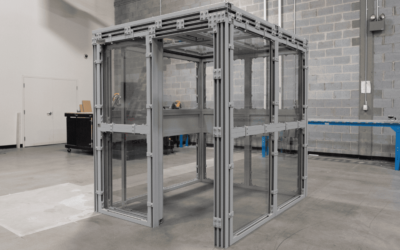Here at TotalShield, we work closely with customers across various industries who rely on high-speed rotating equipment for a range of procedures. These machines are critical to daily operations but also come with risks. When rotating equipment fails, it can release high-energy projectiles or explosive gases, threatening both personnel and infrastructure.
That’s why we design and manufacture custom shielding solutions to help our customers reduce risk, protect people, and maintain operational uptime.
Keep reading to learn more about the types of equipment we protect, the hazards we help contain, and how we approach shielding design for rotating machinery.
How we started designing rotating machinery protection
Our work in rotating machine protection started with a centrifuge at the Department of Energy in Amarillo, Texas. At the time, the industry standard for enclosing high-speed equipment was heavy steel or concrete, effective at containing failures, but expensive, difficult to install, and opaque. For a facility that needed both protection and visibility, those options weren’t workable.
Our founder, Keith Snyder, a mechanical engineer and senior technical staff member at Sandia National Laboratories, led the effort to develop something better. Drawing on his experience building weapons-testing fixtures, he engineered and patented a modular enclosure system using clear polycarbonate sheets mounted in unistrut framing made of steel and aluminum. The result was a transparent enclosure that could contain high-velocity projectiles without the cost or weight of concrete.
This system used standard 4-by-8-foot panels in U-channels that could accept multiple thicknesses of polycarbonate, depending on the impact threat. The entire enclosure was assembled and wired in four days by a four-person team at one-tenth the cost of a comparable concrete structure. And because it was modular, it could be disassembled for equipment maintenance or reconfiguration of the test cell.
The real breakthrough wasn’t just the materials but the way the machine enclosure balanced strength, flexibility, and visibility. Operators could confirm the area was clear before startup and monitor the machinery during operation, key for safe, real-time testing. What began as a specialized solution for a national lab has since become the basis of the shielding systems we now design across a range of industries.
Types of rotating equipment
Rotational machinery is used in a wide range of industrial applications, from refining processes to testing aerospace components. Some of the most common equipment we help shield includes:
- Centrifuges: Used in the gas and oil industries to transport and process gas, separate chemicals or mud, and more; and in aerospace to test components under simulated gravity conditions. These tests involve high rotational speeds, and when failures occur, the fragmented units can be ejected with tremendous force.
- Industrial fans, drills, and turbochargers: These machines compress gases by rotating at high RPMs. Internal explosions or rotor misalignments can launch components unpredictably.
- Pumps: Equipment that often operates under high pressure. When liquid movement is involved, mineral buildup or cavitation can degrade internal components and lead to sudden failure.
In many of these systems, particularly in fans and turbochargers, the machinery’s built-in guarding is not designed to contain a high-impact event. That’s where we come in.
Causes of failure in rotating machinery
The root cause of a failure can vary, but we frequently see the following hazards:
- Chemical degradation: Many of these machines handle gas mixtures that can degrade materials over time, especially with poor maintenance.
- Imbalance and misalignment: A misaligned rotor in a fan can fracture due to repeated stress. Once it breaks, fragments may be expelled at high velocity.
- Cavitation in pumps: Rapid pressure changes can create vapor bubbles that collapse with force, leading to erosion, pitting, noise, and eventual structural fatigue.
- Accumulation of solids: Liquids that contain minerals can lead to weight imbalance over time, creating conditions for rupture or explosive failure.
What all these failure modes have in common is unpredictability. Once the energy becomes uncontained, the resulting projectiles can travel in any direction. And while we can calculate force, we cannot calculate direction.
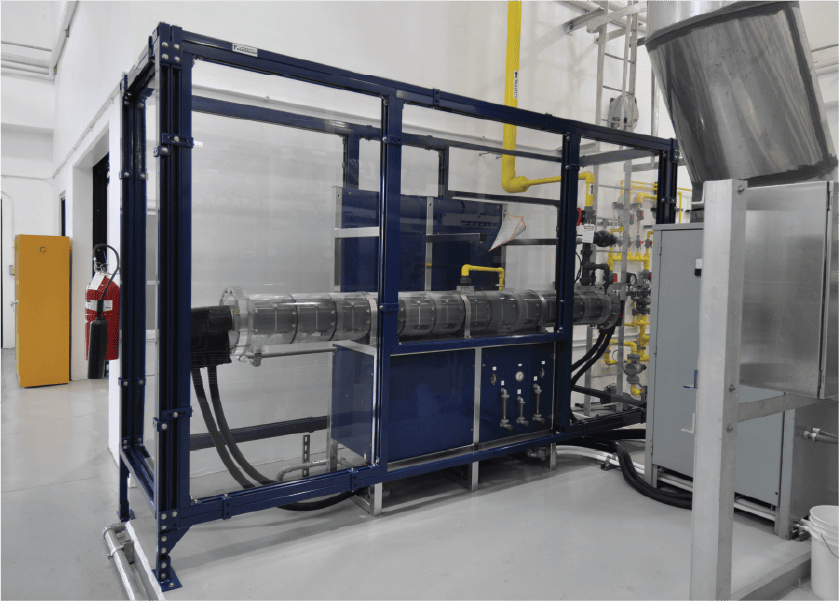
Shielding solutions for rotational machinery protection
When protecting high-speed rotating machinery, standard machine guards just don’t cut it. Most are built to prevent accidental contact or intrusion, not to contain high-energy failures. That’s why we offer and design two types of machine shielding solutions: explosive-resistant blankets and polycarbonate shielded enclosures. Each serves a different purpose and can often be combined.
Explosive Resistant Blankets
Kevlar blankets are ideal for fragmentary protection. These are commonly used with smaller equipment, such as fans or turbochargers, where visibility is not necessary.
These blankets are used in applications where high-speed components such as fans, turbochargers, or centrifuges could fail and eject fragments at high velocity. They’re built to handle the ballistic threat of shrapnel from rotating elements that fracture under stress, imbalance, or fatigue.
Our explosion-resistant blankets use layered aramid fiber cores combined with rugged outer layers to provide high ballistic resistance. We calculate the level of containment needed based on real-world test data, considering the mass, speed, and likely impact points of projected failures.
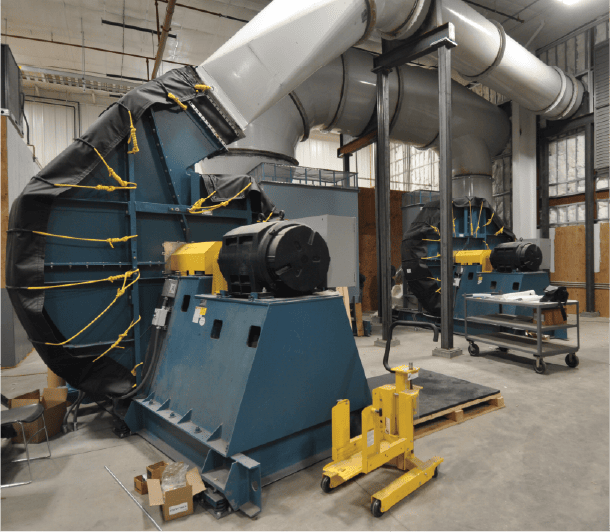
Our Kevlar-based ballistic blankets are engineered to handle:
- Fragmentation hazards from fractured rotors or blades
- Explosive risks due to trapped or compressed gases in compressors and turbines
They are also:
- Custom-shaped to fit around irregular or constrained setups
- Secured with integral Kevlar tie-downs to prevent slippage or gaps
- Removable, making them ideal for applications that require flexible protection without full enclosures
We often deploy them as standalone containment or as part of a layered protection system alongside enclosures or shielded rooms. They are especially effective when visibility isn’t required and access is limited during operation.
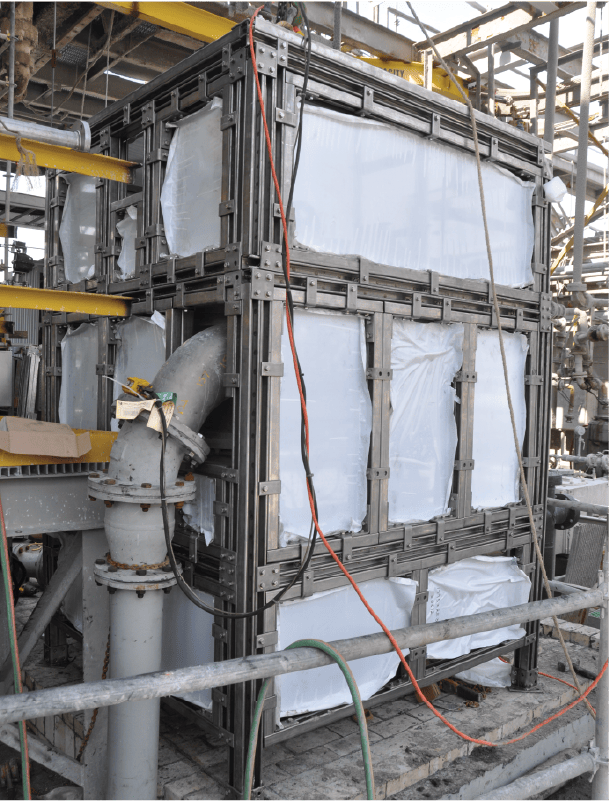
Shielded Enclosures
For applications requiring visibility, access, and robust containment, we offer custom polycarbonate shielded enclosures designed to contain explosive overpressure and directional projectiles. These enclosures are designed for close-perimeter guarding, built with certified impact-rated polycarbonate panels and reinforced frames that have undergone rigorous testing.
Our enclosures are made to contain the kinetic energy of fragments from high-speed failures and reduce the risk to personnel nearby. They’re especially suited for:
- Test stands
- Industrial machinery in production environments
- Equipment connected to multiple systems
Our enclosures
- Surround the machine closely, reducing the risk radius
- Include removable panels for maintenance and inspection
- Can be customized to accommodate crane access or complex geometries
- Are built with steel and aluminum framing for structural integrity and anchoring
We’ve designed and manufactured everything, from compact 2x2x2 ft enclosures to 20 ft shielding rooms with retractable roofs for overhead crane access. No building permits are required, and all units are manufactured in the U.S. with precision and compliance in mind.
Together, our ballistic-resistant blankets and machine enclosures can provide primary and secondary containment. This means isolating higher-risk areas inside shielding rooms or separating mixed-threat zones, like pressure and rotational tests, within the same facility.
Primary and secondary containment
In some testing scenarios, the risk associated can be extremely high and may involve multiple simultaneous threats, including both explosive forces and high-impact projectiles. In these cases, we typically recommend implementing two levels of protection.
Primary containment is the first layer of defense. For fragmentation hazards, this can be achieved using a Kevlar shielding blanket. When the threat involves a major explosive failure, we suggest a shielding room. This is because explosive overpressure, even when not immediately visible, can cause significant structural damage and pose a serious risk to nearby personnel. That pressure must be properly contained and safely vented into the environment.
We also apply this dual-protection approach in test rooms where different threat levels or multiple testing procedures are being performed within the same area. In these cases, the level of containment can be increased in specific zones, with the secondary containment provided by a shielding room. Depending on the layout and threat types, we may also use tabletop enclosures or shielding barriers. This allows separate test zones, such as pressure and rotational testing, to operate safely within a single room.
Our process for designing Machine Shielded Enclosures
We take a structured, collaborative approach to designing protective enclosures for rotational machinery:
- Hazard identification: Our customer shares their procedure concerns, often based on past failures or specific operational knowledge.
- Sizing and threat estimation: We use our Testing Database, developed over 20 years, to assess the threat level based on RPM, mass, and radius. If our customer has prior failure analysis, we use kinetic energy and IED density calculations to select the appropriate protection.
If the scenario exceeds our archive, we partner with third-party testing labs to model and validate forces using simulations or physical testing.
- Custom manufacturing and installation: We design shielding around not only the equipment, but also the operational context. We ask if an operator needs to enter the room, if an overhead crane would be used, or if electrical and communication lines need to be routed through the shield.
For example, a customer recently approached us about a rotational test fixture. We recommended a portable 2x2x2 ft shielded enclosure with lockable casters and benchtop height for flexibility and safety.
Custom Machine Guarding for hard-to-fit areas
Many customers need enclosures after the equipment is already installed. This could be the result of a safety audit, an unexpected failure, or new testing protocols. In these cases, our modular designs allow panels to be installed around existing machinery with minimal disruption.
One example is our work with large industrial centrifuges. We’ve designed machine enclosures with removable top halves and cutouts for piping to accommodate existing configurations.
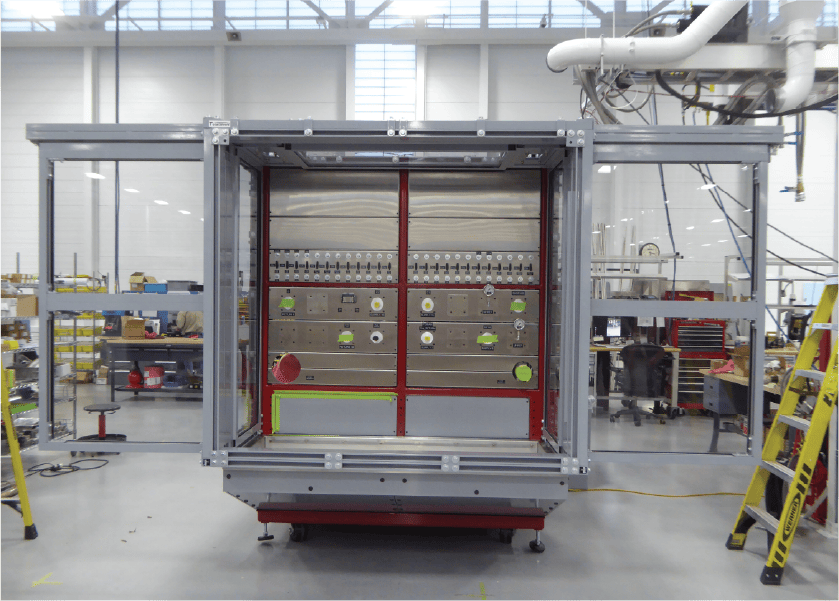
Machine Shielding for safety and flexibility
We understand that rotational machinery varies widely in size, purpose, and threat level. That’s why we offer tailored solutions, from Kevlar blankets for small units to fully enclosed shielding rooms for large-scale test operations. Our experience across industries, from aerospace to industrial processing, has taught us that no two scenarios are alike.
If your team is working with hazardous rotating equipment and you need help designing a containment solution, we’re ready to step in. Contact us today to discuss your custom shielding solution.




